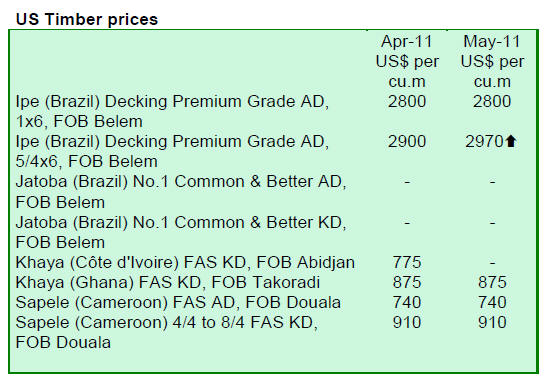|
Report
from
North America
Little change in total sawn hardwood imports
There was little improvement in US imports of sawn
tropical hardwood from March to April 2011. Imports of
sawn tropical hardwood declined by 1% to 15,969 cu.m. in
April, but on a year-to-date basis imports grew by 16%
from 2010.
Imports of balsa were 3,866 cu.m. (-13% year-to-date), ipe
2,151 cu.m. (+43% year-to-date), keruing 1,869 cu.m.
(+184% year-to-date), acajou d¡¯Afrique 1,547 cu.m. (-4%
year-to-date), mahogany 1,378 cu.m. (+11% year-to-date),
and virola 1,023 cu.m. (+85% year-to-date).
Imports from the largest supplier to the US, Ecuador and
Brazil recovered in April. Ecuador shipped 4,024 cu.m. of
mainly sawn balsa in April. Imports from Brazil were
3,500 cu.m. with ipe accounting for more than half of the
volume.
Imports from Malaysia increased to 2,167 cu.m. because
of strong demand for keruing. Monthly import volumes of
key imported species by country of origin are shown
below.
Strong growth in hardwood plywood imports from China
The US imported 247,922 cu.m. of hardwood plywood in
April 2011, up 47% from March and 21% compared to
year-to-date April 2010. This upswing in spring demand
benefitted mainly Chinese suppliers.
Imports from China were 171,496 cu.m. (+53% year-todate),
but tropical countries saw a decline in shipments to
the US: imports from Indonesia were 21,028 cu.m. (-9%
year-to-date), from Malaysia 6,755 cu.m. (-42% year-todate),
and from Ecuador 4,214 cu.m. (-8% year-to-date).
Brazil remains largest hardwood moulding supplier
The upswing in hardwood moulding imports continued in
April 2011. Total imports were worth US$18.7 million, up
6% from March and 23% year-to-date. The smaller
suppliers Mexico, Paraguay, Taiwan and Bolivia have
increased their share in the US market since late 2010.
Imports from Brazil declined by 14% from the previous
month to US$7.2 million, but Brazil remains the largest
hardwood moulding supplier to the US with year-to-date
imports 59% above 2010 levels.
Imports from China increased by 47% to US$4.5 million
(+8% year-to-date). Hardwood moulding imports from
Malaysia were US$1.8 million (+50% year-to-date) and
from Indonesia US$426,000 (+3% year-to-date).
Slow growth in hardwood flooring imports
Hardwood flooring imports increased again in April 2011,
but imports remain relatively low compared to prerecession
levels. Total imports were worth US$1.8 million
in April, up 83% year-to-date.
After two months of decline, imports from China were up
in April at US$460,000 (+88% year-to-date). Malaysia
shipped US$309,000 in April (+130% year-to-date), while
imports from Brazil were US$238,000 (+42% year-todate).
Flooring imports from Indonesia were US$231,000
(+622% year-to-date).

First national forest industry check-off programme approved
A majority of the US sawn softwood industry voted to
approve a promotional programme for sawn softwood.
The so-called check-off is industry-managed and financed
but overseen by the US Department of Agriculture.
All softwood sawnwood companies will have to pay
US$0.35 per thousand board feet produced or imported
into the US, excluding volumes below 15 million board
feet. The projected income would be US$12-19 million
per year, depending on shipments levels.
The programme has been developed by a committee of 21
major softwood sawnwood manufacturers in the US and
Canada. In the past, voluntary programmes with similar
goals were not effective, and the industry hopes that this
mandatory approach will provide sustainable funding for a
long-term program.
The programme will develop consumer and industry
information and advertising designed to expand markets
for softwood sawnwood, including export markets, and
develop new applications such as cross-laminated timber.
New cross-laminated timber plant in British Columbia, Canada
A cross-laminated timber plant opened in Okanagan Falls,
British Columbia in June 2011. The 1,400 sq.m. plant is
owned by glulam producer Structurlam and was supported
by C$5.7 million in government funding.
Cross-laminated timber (CLT) is a multi-layer solid timber
panel made from dimensional sawn softwood. The
engineered wood product was developed in Europe, but
efforts are underway in North America to create standards
to make it easy for engineers to specify CLT in building
construction.
CLT provides an opportunity to expand the use of wood in
non-residential construction in North America where
concrete and steel currently dominate. Building assembly
with CLT panels is fast and CLT can be used in the long
spans common in commercial buildings. Part of the
Canadian government funding went into developing a
technical guide on CLT manufacturing, design and
construction. More information on the CLT Handbook is
available at:
http://www.fpinnovations.ca/
Federal budget will again support Canadian forest industry
The newly elected federal government passed its 2011
federal budget that will invest C$60 million in innovation
and product development in Canada¡¯s forest industry.
The industry accounts for 12% of Canada¡¯s manufacturing
GDP and employs approximately 300,000 according to the
Forest Products Association of Canada. Since 2003, about
38,000 jobs have been lost for a variety of reasons,
including increased competition from South America and
Asia as well as the downturn in the US market.
Related News:
|